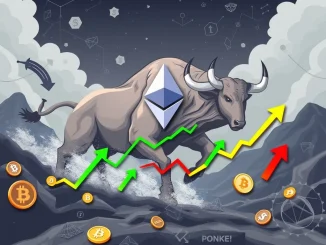
Hold onto your hats, crypto enthusiasts! The Ethereum waters are getting choppy as massive whale movements have just been detected. In a sudden flurry of activity, Ethereum whales have offloaded a staggering $27 million worth of ETH in a single hour. Is this a minor ripple or the start of a bigger wave in the crypto market? Let’s dive into the details and see what’s happening beneath the surface.
What’s Triggering This Ethereum Whale Sell-Off?
According to the eagle-eyed blockchain analysts at Lookonchain, posted on X, two significant Ethereum wallets have been making some serious moves. Let’s break down exactly what went down:
- Wallet 0xc19D made a substantial deposit of 8,922 ETH directly to the Kraken exchange. At current prices, this colossal stack of ETH is valued at approximately $14 million. Depositing to an exchange often signals an intent to sell.
- Simultaneously, Wallet 0x4e7a executed a large ETH sell-off, offloading 8,000 ETH. This sale was executed at a price of $1,632 per ETH, netting them a cool $13.06 million.
Here’s a quick summary in a table for a clearer picture:
| Wallet | Action | Amount (ETH) | Value (USD) | Platform/Price |
|---|---|---|---|---|
| 0xc19D | Deposit | 8,922 | $14 million | Kraken Exchange |
| 0x4e7a | Sell | 8,000 | $13.06 million | $1,632 per ETH |
| Total | Offload | 16,922 ETH | $27.06 million |
This synchronized ETH sell-off by multiple large holders raises eyebrows and prompts the crucial question: Why now? What factors could be driving these Ethereum whales to liquidate such significant portions of their holdings?
Decoding the Motives Behind Massive ETH Moves
Pinpointing the exact reasons behind whale actions is always speculative, but we can consider several plausible scenarios that might be influencing these massive ETH moves:
- Profit Taking After Gains: Ethereum has seen periods of price appreciation. Whales who accumulated ETH at lower prices might be capitalizing on recent gains to secure profits. This is a common strategy in any market, especially after periods of volatility.
- Anticipation of Market Correction: Experienced traders, including whales, are adept at anticipating market shifts. This ETH sell-off could indicate a strategic move to reduce exposure in anticipation of a potential market correction or downturn. Selling now could allow them to buy back in at lower prices later, increasing their holdings in the long run.
- Diversification into Altcoins or Other Assets: Whales might be reallocating capital. The funds from this Ethereum sell-off could be earmarked for investment in other promising altcoins, emerging DeFi projects, or even traditional assets. Diversification is a risk management strategy employed by large investors to spread their investments across different asset classes.
- Liquidation to Cover Other Positions: In some cases, large holders might need to liquidate assets like ETH to cover margin calls or obligations in other parts of their investment portfolios. While less common, it’s a possible factor, especially in highly leveraged trading environments.
- Macroeconomic Factors: Broader economic conditions, regulatory news, or geopolitical events can influence market sentiment and trigger large-scale movements. Uncertainty in the global economy can sometimes prompt investors to reduce exposure to riskier assets like cryptocurrencies.
Impact on Ethereum Price and the Broader Crypto Market
Large ETH sell-offs by whales can undoubtedly exert downward pressure on the Ethereum price, at least in the short term. Here’s how such activity can impact the market:
- Increased Supply, Potential Price Drop: When a significant amount of ETH is suddenly introduced into the market through sales and exchange deposits, it increases the available supply. Basic economics dictates that increased supply, without a corresponding increase in demand, can lead to a decrease in price.
- Market Sentiment and Fear, Uncertainty, and Doubt (FUD): Whale movements are closely watched by the crypto community. Large sell-offs can trigger fear, uncertainty, and doubt (FUD) among other investors, potentially leading to further selling pressure and amplifying the downward price movement.
- Liquidity and Volatility: Large trades can impact market liquidity and increase volatility. Sudden sell orders can be filled at lower prices if liquidity is thin, leading to rapid price swings.
- Potential for a Domino Effect: If the Ethereum price drops significantly due to whale selling, it can trigger stop-loss orders and liquidations in leveraged positions, potentially creating a domino effect and further accelerating the price decline across the broader crypto market.
However, it’s crucial to remember that the crypto market is dynamic. Whale sell-offs don’t always lead to prolonged downturns. Sometimes, they can present buying opportunities for other investors who believe in the long-term potential of Ethereum.
What Does This Mean for Ethereum Investors? Actionable Insights
For those invested in Ethereum or considering entering the market, these whale movements serve as a crucial reminder of the inherent volatility and the influence of large holders. Here are some actionable insights:
- Stay Informed and Monitor Whale Activity: Tools like Lookonchain and other blockchain explorers provide valuable data on whale transactions. Keeping an eye on these movements can offer clues about potential market shifts.
- Manage Risk and Diversify Your Portfolio: The crypto market is inherently risky. Diversification across different assets and risk management strategies, such as setting stop-loss orders and allocating a comfortable percentage of your portfolio to crypto, are essential.
- Don’t Panic Sell Based on Whale Activity Alone: While whale movements are noteworthy, avoid making impulsive decisions based solely on these actions. Conduct your own research, consider your investment strategy, and assess the broader market context.
- Look for Buying Opportunities (Potentially): If you believe in the long-term fundamentals of Ethereum, price dips caused by whale sell-offs could present potential buying opportunities. However, always exercise caution and due diligence.
- Understand Market Volatility: Whale activity is just one factor contributing to crypto market volatility. Be prepared for price swings and invest with a long-term perspective, if your strategy aligns with that.
In Conclusion: Navigating the Ethereum Waters
The recent Ethereum whale sell-off of over $27 million ETH is a significant event that underscores the dynamic and sometimes unpredictable nature of the cryptocurrency market. While the exact motives behind these massive ETH moves remain speculative, it’s a clear signal for investors to remain vigilant, informed, and prepared for potential market fluctuations. By staying abreast of whale activity, managing risk effectively, and conducting thorough research, you can navigate the exciting, yet sometimes turbulent, waters of the Ethereum and broader crypto landscape. Is this the start of a major correction, or just profit-taking before the next surge? Only time will tell, but being informed is your best asset in the crypto world.



